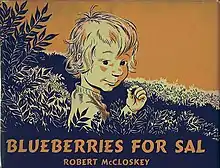Blueberries for Sal
Blueberries for Sal is a children's picture book by Robert McCloskey. It was awarded the Caldecott Honor in 1949.[1]
 First edition cover | |
| Author | Robert McCloskey |
|---|---|
| Illustrator | Robert McCloskey |
| Cover artist | Robert McCloskey |
| Country | United States |
| Genre | Children's picture book |
| Publisher | The Viking Press |
Publication date | 1948 |
| Media type | Hardback, Paperback and Kindle Edition |
| Pages | 55 |
| ISBN | 0-670-17591-9 |
The story features a little girl, Sal, and her mother as they go and pick blueberries for winter—and a bear cub and his mother as they go and eat berries for winter from the other side of the same hill. Set in a small town in Maine this picture book piece uses a single dark blue color and block printing for the illustrations. Sal and Sal's mother are modeled after McCloskey's daughter, Sally, and wife Peggy.
Blueberries for Sal was ranked number 13 among the "Top 100 Picture Books" in a 2009 survey published by School Library Journal.[2] It was ranked number 31 in a reiteration three years later.[3]
Plot summary
"The book opens and closes with a picture of little Sal and her mother in the kitchen, the mother is canning blueberries... One sees in this opening picture Sal entertaining herself by placing the canning rings on her wrist and a spoon, a simple childlike act which helps to set the stage for Sal's obvious child actions throughout the books. This is not to be the overly diligent or angelic girl of so many other books, Sal is a real child figure. She gets into mischief and causes her mom no end of trouble.”[4]
Little Sal's Mother takes her to Blueberry Hill to pick berries. Sal drops three berries in her bucket, then eats them. This continues as she and her mother concentrate on the berries and gradually get separated on the hill. What they don't realize is that a mother bear and her cub have also come to Blueberry Hill to eat berries for the winter. The book uses a number of visual and verbal techniques to compare and contrast the bear and the human families. Both families pictures are similar in compositions, but they head in opposite directions when they reach the blueberry patch. Little Sal’s Mother tells her that they can’t eat all the berries because they need to save them to can for the winter, but the bear mother tells her child to eat as much as it can to store up fat for winter. The bear's way of preparing for winter is more natural for Sal who soon wanders off to eat.
Sal and the bear cub get mixed up and follow after the wrong mother. It takes the mothers several minutes to realize they're being followed by the wrong child; it isn't until the bear cub tries to eat from Sal's mother's bucket and the mother bear hears the "ku-plink, ku-plank, ku-plunk" sound of Sal dropping blueberries into her tin pail that they realize what happened. Ultimately each child is reunited with its proper mother and they both leave the hill. Just before leaving Sal drops a blueberry into her empty pail. The end papers show Sal again playing in the kitchen while her mother cans berries.
A sequel, One Morning in Maine, takes place a few years later, and revisits little Sal and her mother, and introduces Sal's father and younger sister.
Film adaptation
The book was adapted as a short film in 1967 by Weston Woods, narrated by Owen Jordan. The short simply consisted of shots of the original book's illustrations - colorized therein - and featured a musical score performed entirely by woodwind instruments. This short film is included on the Scholastic DVD Make Way for Ducklings and More Robert McCloskey Stories (2004), along with Make Way for Ducklings and Time of Wonder.
References
- Caldecott Medal & Honor Books, 1938-Present
- Bird, Elizabeth (April 30, 2009). "Top 100 Picture Books, #13". A Fuse #8 Production. Archived from the original on May 19, 2012. Retrieved 2012-05-20.
- Bird, Elizabeth (July 6, 2012). "Top 100 Picture Books Poll Results". A Fuse #8 Production. Blog. School Library Journal (blog.schoollibraryjournal.com). Archived from the original on December 4, 2012. Retrieved 2015-10-05.
- Zeluna, Children's Books, Children's Literature, and Picture Book analysis
